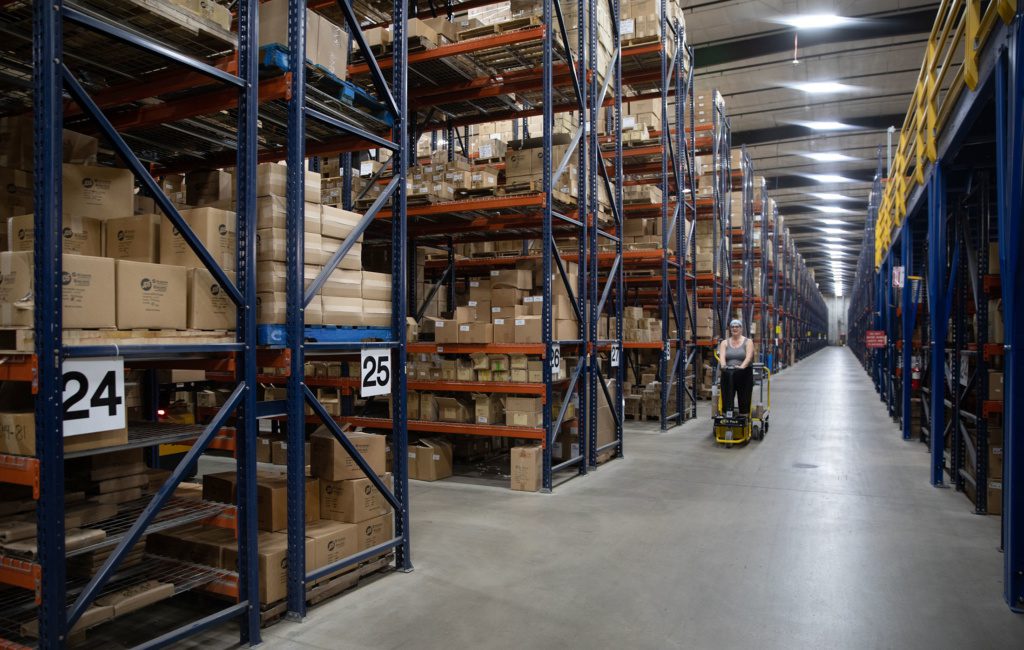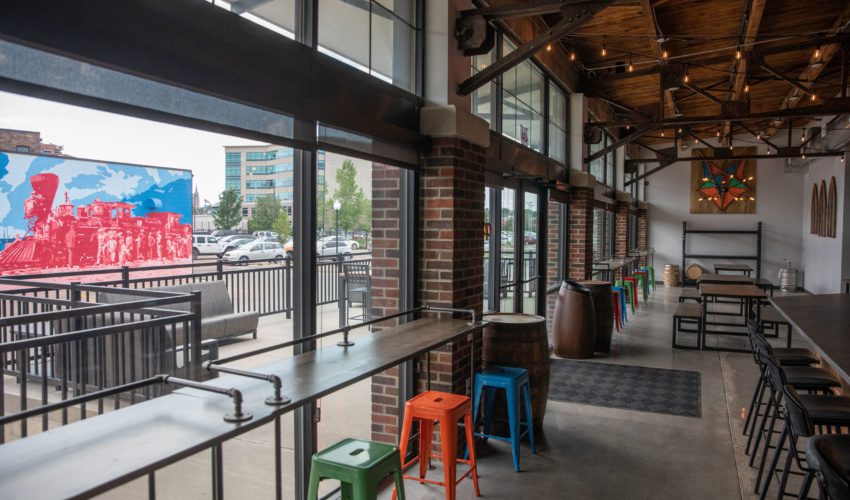With warehouse space at premium, businesses endure ‘sleepless nights’ managing inventory
Dec. 16, 2021
When Dugan Sales & Services expanded its appliance business with a new store in Sioux Falls earlier this year, co-owner Jeremy McBurney was offered the chance to lease a warehouse not far from his 41st Street location.
He didn’t think “there’s ever a way we will fill 30,000 square feet with appliances,” he said.
But he signed the lease anyway, figuring he could always sublease.
One recent morning, “I had to refuse a semi-truck … because we’re full,” he said. “We are full. To the point where I’ve toyed with the idea of renting a few pods to put out back. It’s turned out to be a really good thing for us.”
The strong community response to his business combined with ongoing supply chain issues has required more storage space than he anticipated even a year ago, he said.
“We are super grateful for the great community response,” he said. “There’s a housing shortage, they can’t build apartments fast enough, so some of it is that we have a product people need. But we’ve been blessed, and it’s been good – not without sleepless nights trying to make sure we have enough inventory.”
There likely have been similar restless nights citywide, as warehouse space has become increasingly sought after. When Bender Commercial Real Estate Services released its midyear market report in July, the industrial vacancy rate had dropped to 1.6 percent from 4.1 percent in 2020, as the market absorbed space faster than new space came available.
It likely will be a similar story as Bender executive vice president and managing director Rob Fagnan surveys the market again soon, he said.
“As quickly as buildings have been put up, they’ve been absorbed,” he said. “There is such limited space out there.”
He recently looked at availability of warehouse options with at least a single dock and found a total of 200,000 square feet, collectively, across the entire Sioux Falls metro area.
“And the majority of that was tied up in one or two buildings,” he said.
Construction prices are prohibiting many investors from building warehouses on speculation, he continued. The lease rate that would need to be charged for it to make sense “just continue to inflate, and it gets to a point where tenants aren’t willing to pay,” he said.
“There are other investors that are going to go spec … but it comes down to input costs on the group. If you own the ground outright, obviously that input cost is a lot less.”
In the meantime, many deals are happening before or right after properties go on the market.
Dugan Sales & Service was able to lease its warehouse because Montgomery’s moved to a larger one. The furniture business was able to move to its new space because the former Heartland Paper Co. warehouse became available.
It hadn’t yet gone on the market, “and we sat down and made a deal in a week and closed in six weeks,” president Eric Sinclair said.
“Those are the types of things happening to some degree because there’s such a high demand if anyone hears an inkling there’s a warehouse for sale.”
The new space offers Montgomery’s four times the capacity, which has been necessary as demand for furniture met supply chain uncertainty.
“It’s almost full,” Sinclair said. “We can’t control the supply chain, and demand is so high for home furnishings. I’m not willing to even consider running out of product, so we put a lot of product in here.”
He’s also ordering more inventory than he typically would and bracing for big swings in estimates versus delivery times. In some cases, manufacturers are forcing retailers to plan up to a year ahead, “but the reality is they don’t have any idea when they’re going to produce it,” Sinclair said.
“You’re planning these orders when they said it ships a year from now, and two month later, they acknowledge it to be shipped in three months, so your 12 months turned into six, and all this product you ordered for the next year is coming six months early. It’s causing people to be very desperate for warehouse space.”
Businesses are having to get creative, Fagnan added.
“Maybe share space with a client or friend that operates an alternative business, or do you go pay more for the flexibility of using a (third-party) warehouse, if you can find it,” he said. “If I need a dock, I might need to deal with a trailer pulling up and a forklift bringing it through a grade-level door. It’s not efficient, but if I want to grow, I have no choice. Or there’s makeshift lean-tos that are being built off the side of buildings.”
While there are investors coming into the market looking to build warehouse space, all construction faces some level of challenge, he added. Even a basic metal 10,000-square-foot building with overhead and dock doors can take more than 32 weeks for delivery of the building, he said.
“We have seen a lot of deals done off market,” Fagnan added. “We know someone is moving out, and we know someone looking for space. There have been deals done that way.”
In Montgomery’s case, Sinclair offered his former warehouse to a couple of people he knew needed space. Two out of three said yes. Dugan’s McBurney had a lease done in a couple of days.
“And it’s turned out we needed all that and more,” McBurney said. “I’m really grateful we got the space when we did.”
Businesses that rely on warehouses in other markets face additional challenges.
JDS Industries, which is based in Sioux Falls but has warehouses nationwide, closed its Los Angeles warehouse earlier this year after looking at a 50 percent increase.
“And it was already my most expensive warehouse space in the country,” CEO Scott Sletten said.
“Warehouse space is a challenge as the price of it is increasing rapidly. In our new online economy, many more companies need space to do fulfillment from and not the retail space that they used to need.”
His Sioux Falls warehouse space “is fine for now as we cannot get the inventory we would like to get,” Sletten added.
“If we were fully stocked though, I would be looking at expansion.”
Other large businesses encountering similar warehousing challenges nationwide are considering expansions in Sioux Falls, Fagnan said.
“Anywhere from 5,000 up to 250,000 square feet,” he said. “We’re starting to see a lot of large users enter our market. Logistically, if you’re a large corporation that needs a hub with immediate access to interstates going north, south, east and west, Sioux Falls is a perfect crossroads for that as a tertiary market.”
That is, if you can find a space.
“When someone is looking for 20,000 or 250,000 square feet in Sioux Falls and it doesn’t exist, your next option is to look regionally,” Fagnan said. “These corporations need space, and they need it now. They don’t have time to wait a year or longer to get space. So if there’s an existing building on the outskirts of Minneapolis or in Des Moines or Omaha they can occupy fairly quickly, all of a sudden we get eliminated as a market for them to come to until some point in the future.”















